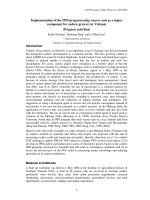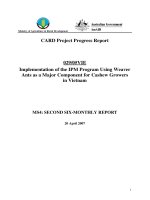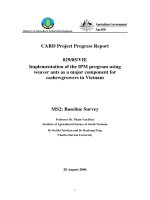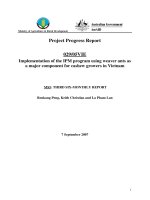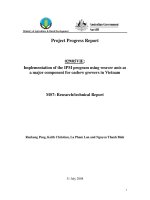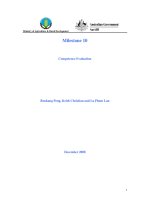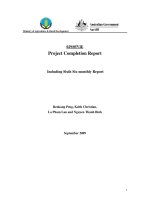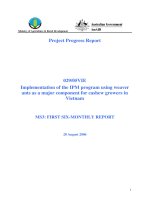Fabrication of polymeric ultrafiltration membranes using ionic liquids as green solvents
Bạn đang xem bản rút gọn của tài liệu. Xem và tải ngay bản đầy đủ của tài liệu tại đây (6.68 MB, 161 trang )
FABRICATION OF POLYMERIC ULTRAFILTRATION
MEMBRANES USING IONIC LIQUIDS AS GREEN SOLVENTS
XING DINGYU
(B. Eng, Zhejiang University, P.R. China)
A THESIS SUBMITTED
FOR THE DEGREE OF DOCTOR OF PHILOSOPHY
DEPARTMENT OF CHEMICAL AND BIOMOLECULAR
ENGINEERING
NATIONAL UNIVERSITY OF SINGAPORE
2012
Ph.D thesis
i
DECLARATION
Ph.D thesis
i
ACKNOWLEDGEMENT
I would like to acknowledge the people who made the journey of my PhD study a
wonderful and rewarding experience. First, I want to thank my academic advisor,
Professor Chung Tai-Shung. He has given me every opportunity to learn about membrane
science and provided well equipped facilities to carry out my research. The journey to the
accomplishment of the PhD degree is certainly full of challenges; Prof. Chung has
impelled me to achieve what I never imagine and trained me as an independent
researcher. His attitude towards work is helpful to my growth in areas extending beyond
research work. I wish to express my sincere appreciation to Prof. Chung for his teaching
and guidance.
Thanks are dedicated to Professor Jiang Jianwen and his staffs for their great help on
simulation works. Special thanks are due to all the team members in Prof. Chung’s
research group. Dr. Peng Na is especially recognized for her guidance and help in my
research works from the first day I joined this group. With her support in both research
and life, I could progressively make the way in these four years. I would like to convey
my appreciation to Dr. Wang Kaiyu, Dr. Su Jincai, Dr. Teoh May May, Dr. Wan Yan,
Dr. Ge Qingchun and Dr. Xiao Youchang for their valuable advice to my work, and for
sharing their knowledge and technical expertise with me. My gratitude extends to Ms
Zhang Sui, Ms Zhong Pei Shan and Ms Wang Huan for their suggestions and support in
the past years. It is my treasure to make so many friends here. All members in Prof.
Ph.D thesis
ii
Chung‘s group are cheerful and helpful to me which have made my study in NUS
enjoyable and memorable.
I gratefully acknowledge the research scholarship by the National University of
Singapore. I would like to thank the NUS initiative grant for life science (R-279-000-249-
646), the NRF CRP grant for energy development (R-279-000-261-281), and
GlaxoSmithKline-Economic Development Board (GSK-EDB) Trust Fund for the project
entitled “New membrane development to facilitate solvent recovery and pharmaceutical
separation in pharmaceutical syntheses” with the grant number R-706-000-019-592. I
also thank BASF, Eastman and PBI Performance Products, Inc. for the provision of
materials.
Last but foremost, I wish to thank my family and friends for their constant support, love
and encouragement throughout my candidature.
Ph.D thesis
iii
TABLE OF CONTENTS
ACKNOWLEDGEMENT i
TABLE OF CONTENTS iii
SUMMARY viii
LIST OF TABLES xi
LIST OF FIGURES xii
NOMENCLATURE xvii
Chapter 1 Introduction 1
1.1 Characteristics and advantages of ionic liquids 2
1.2 Applications of ionic liquids in recent polymer science 5
1.3 Application of ionic liquids in membrane science 7
1.4 Research objectives 7
Chapter 2 Literature Review on Membrane Technology 10
2.1 Development of polymeric membrane for liquid separation 10
2.2 Theoretical background on phase inversion in membrane formation 13
2.2.1 Phase diagrams and phase inversion 13
2.2.2 Fabrication of flat sheet and hollow fiber membranes 17
Chapter 3 Fundamentals and characteristics of membrane formation via phase
inversion for cellulose acetate membranes using an ionic liquid,
[BMIM]SCN, as the solvent 23
3.1 Introduction 23
Ph.D thesis
iv
3.2 Experimental 24
3.2.1 Materials 24
3.2.2 Phase diagrams, dope preparation and viscosity measurements 24
3.2.3 Fabrication of flat asymmetric membranes 26
3.2.4 Fabrication of hollow fibers 26
3.2.5 Morphology study 27
3.2.6 Ultrafiltration tests for pure water flux and pore size distribution 27
3.2.7 Membrane porosity 30
3.2.8 Recovery and reuse of [BMIM]SCN 30
3.3 Results and discussion 30
3.3.1 Solubility, viscosity curves and phase diagrams of CA in ionic liquids 30
3.3.2 The effects of solvents on CA flat sheet membranes 33
3.3.2.1 The morphology of CA flat sheet membranes 33
3.3.2.2 Porosity, pure water permeability, pore size and its distribution of CA flat
sheet membranes 37
3.3.3 Fabrication of CA hollow fiber membranes from [BMIM]SCN and the
morphology study 40
3.3.4 Recovery and reuse of [BMIM]SCN for membrane fabrication 43
3.4 Conclusions 44
Chapter 4 Investigation of unique interactions between cellulose acetate and ionic
liquid, [EMIM]SCN, and their influences on hollow fiber ultrafiltration
membranes 46
4.1 Introduction 46
4.2 Experimental 48
Ph.D thesis
v
4.2.1 Materials 48
4.2.2 Dope characterizations - FTIR, rheology, phase inversion kinetics and phase
diagrams 49
4.2.3 Molecular simulation by Materials Studio 50
4.2.4 Fabrication of CA flat sheet and hollow fiber membranes 51
4.3 Results and discussion 52
4.3.1 The molecular interactions between CA and ionic liquids 52
4.3.2 The rheology of CA/[EMIM]SCN solutions 55
4.3.3 Phase inversion of CA/[EMIM]SCN in different coagulants 58
4.3.4 Hollow fiber membrane morphology and ultrafiltration characterizations 64
4.3.4.1 Effects of dope flow rate and dope temperature 66
4.3.4.2 Effects of air-gap distance 70
Chapter 5 Molecular interactions between polybenzimidazole and [EMIM]OAc, and
derived ultrafiltration membranes for protein separation 74
5.1 Introduction 74
5.2 Experimental 77
5.2.1 Materials 77
5.2.2 Dissolution experiments 78
5.2.3 Molecular simulation by Materials Studio 78
5.2.4 Rheological measurements of PBI/ionic liquid solutions 79
5.2.5 Fabrication of flat asymmetric membranes 79
5.2.6 Thermal treatment and chemical cross-linking of PBI membranes 80
5.2.7 Protein separation performance 80
5.3 Results and discussion 81
Ph.D thesis
vi
5.3.1 Dissolution of PBI in ionic liquids 81
5.3.2 Molecular dynamic simulation of PBI/ionic liquid systems 84
5.3.3 The rheological behavior of PBI/[EMIM]OAc solutions 86
5.3.4 Morphology of PBI asymmetric membranes 89
5.3.5 Protein separation performance 91
5.4 Conclusions 95
Chapter 6 Fabrication of porous and interconnected PBI/P84 ultrafiltration
membranes using [EMIM]OAc as the green solvent 97
6.1 Introduction 97
6.2 Experimental 99
6.2.1 Materials 99
6.2.2 Dope characterizations - Rheological measurements, phase inversion kinetics
of PBI/ionic liquid solutions 101
6.2.3 Fabrication of flat asymmetric membranes 102
6.2.4 Fourier transformed infrared spectroscopy (FTIR) 102
6.2.5 Differential Scanning Calorimetry (DSC) 102
6.3 Results and discussion 103
6.3.1 Solubility of selected polyimides in [EMIM]OAc 103
6.3.2 Interactions in the P84/[EMIM]OAc solution 103
6.3.3 Miscibility of P84 and PBI in [EMIM]OAc 105
6.3.4 The rheological behavior of PBI/P84/[EMIM]OAc solutions 109
6.3.5 Morphology and ultrafiltration performance of PBI/P84 blend membranes 111
6.3.5.1 Effects of polymer composition 111
Ph.D thesis
vii
6.3.5.2 Effects of casting temperatures 116
6.4 Conclusions 118
Chapter 7 Conclusions and recommendations 120
Chapter 8 References 127
Ph.D thesis
viii
SUMMARY
Ionic liquids have gained worldwide attention as green solvents in the last decade. This
study explored, for the first time, the fundamental science and engineering of using ionic
liquids as a new generation of solvents to replace the traditional organic solvents for the
fabrication of flat sheet membranes and hollow fiber membranes. The fundamentals and
characteristics of membrane formation of cellulose acetate (CA) membranes have been
investigated using 1-butyl-3-methylimidazolium thiocyanate ([BMIM]SCN) as the
solvent via phase inversion in water. For elucidation, other solvents, i.e. N-Methyl-2-
pyrrolidinone (NMP) and acetone, were also studied. It is found that [BMIM]SCN has
distinctive effects on phase inversion process and membrane morphology compared to
NMP and acetone because of its unique nature of high viscosity and the high ratio of
[BMIM]SCN outflow to water inflow. Membranes cast or spun from CA/[BMIM]SCN
have a macrovoid-free dense structure full of nodules, implying the paths of phase
inversion are mainly nucleation growth and gelation, followed possibly by spinodal
decomposition. The recovery and reuse of [BMIM]SCN have also been demonstrated and
achieved. The derived flat sheet membranes made from the recovered [BMIM]SCN show
similar morphological and performance characteristics with those from the fresh
[BMIM]SCN.
To further investigate the molecular interactions between ionic liquid, 1-ethyl-3-
methylimidazolium thiocyanate ([EMIM]SCN) and cellulose acetate (CA), we employed
not only experimental characterizations including FTIR and rheological tests, but also
Ph.D thesis
ix
molecular dynamics simulations. Due to the electronic nature of ionic liquids,
[EMIM]SCN interacts with CA molecules through pronounced hydrogen bonding,
coulombic forces and van der Waals interactions, which play an important role in
dissolving CA and also greatly contribute to a three-region flow curve of the
CA/[EMIM]SCN solutions under shear stress. The charge-ordered network in
CA/[EMIM]SCN solutions as well as the affinity and unique solvent exchange
characteristics between non-solvents and [EMIM]SCN are found to greatly influence the
phase inversion paths of membranes. In addition, the effects of dope flow rate, dope
temperature and air-gap distance on hollow fiber formation have been elucidated and
correlated to the interactions between CA and [EMIM]SCN and the phase inversion
mechanisms. By fine-tuning the spinning conditions, CA hollow fiber membranes are
successfully fabricated for ultrafiltration with a PWP value of 90.10 (L/m
2
bar h) and a
mean effective pore diameter of 16.68nm.
Ionic liquid, 1-ethyl-3-methylimidazolium acetate ([EMIM]OAc), was found to be a
promising green solvent to fabricate polybenzimidazole (PBI) membranes for water reuse
and protein separation. [EMIM]OAc exhibits superior efficiency in dissolving PBI under
much lower temperature and pressure compared to the traditional toxic N,N-
dimethylacetamide (DMAc) because the acetate anions of [EMIM]OAc could form
hydrogen bonding with PBI chains and effectively break up the interchain hydrogen
bonding in PBI molecules, verified by molecular simulations. The PBI/[EMIM]OAc
solution also displays unique rheological properties significantly deviated from the
traditional Cox-merz rule, and the shear thinning rheology at low shear rates implies a
Ph.D thesis
x
strong charge-ordered structure resulting from the intense hydrogen bonding. PBI
ultrafiltration membranes are prepared from PBI/[EMIM]OAc solutions by non-solvent
induced phase separation method. The high dope viscosity and a high ratio of
[EMIM]OAc outflow to water inflow facilitate the formation of a relatively thick sponge-
like structure with a few macrovoids. After thermal treatment in ethylene glycol at 140ºC
and chemical cross-linking by dichloro p-xylene, derived PBI ultrafiltration membranes
achieved a high separation factor of 94.55 for a binary protein mixture containing bovine
serum albumin and hemoglobin.
In order to facilitate the fabrication of PBI membranes with a higher water flux by using a
less amount expensive PBI material, five commercially available polyimides and
polyimide-amides were screened and P84 co-polyimide was chosen to blend with PBI
because it formed miscible blends with PBI and interacted closely with [EMIM]OAc.
The incorporation of P84 in the blend system not only lowered the overall viscosity for
easier membrane fabrication but also delayed the phase inversion process favorably to
form a macrovoid-free morphology. PBI/P84 blend membranes were therefore fabricated
for ultrafiltation via non-solvent induced phase inversion method. Compared to plain PBI
ultrafiltration membranes, the newly developed PBI/P84 blend membranes exhibit an
open cell structure and a reduced thickness which result in an increase of the PWP to
around 200 (L/m
2
bar h), as well as an increase of the mean effective pore diameter.
Ph.D thesis
xi
LIST OF TABLES
Table 1-1 Structures of ionic liquids most extensively employed [10] 3
Table 2-1 Membrane Separation Processes and Membrane Characteristics [51] 11
Table 3-1 Properties of solvents and non-solvent 26
Table 3-2 Spinning conditions for CA/[BMIM]SCN membranes 27
Table 3-3 Solubility parameters of solvents, non-solvent and cellulose acetate 31
Table 3-4 Comparison of various parameters (porosity, pore size and pore size
distribution) and PWP performance of CA flat sheet membranes 38
Table 4-1 Spinning conditions for CA membranes 52
Table 4-2 Solubility parameters of solvents, cellulose acetate and non-solvents at 20℃ 55
Table 4-3 Viscosities and diffusivities of water and IPA 58
Table 4-4 Comparison of various parameters and PWP of CA hollow fiber membranes 66
Table 5-1 Molecular simulation results
of PBI/ionic liquid systems 85
Table 5-2 Properties of [EMIM]OAc, DMAc and water 90
Table 5-3 Comparison of PWP, mean pore diameter and geometric standard deviation for
PBI membranes calculated from neutral solute rejection 92
Table 5-4 BSA/Hb separation performance of PBI membranes at different pH values 93
Table 5-5 Basic properties of BSA and Hb 93
Table 6-1 Solubilities of PBI, polyimides and polyamide-imides in [EMIM]OAc at 120
ºC 100
Table 6-2 T
g
values of the PBI/P84 blend systems from the Fox equation and
experimental results 105
Ph.D thesis
xii
Table 6-3 Physicochemical properties of [EMIM]OAc and wate 111
Table 6-4 Solubility parameters of PBI and P84 at 298K calculated according to Hoy’s
table, Fedors’ and Matsuura’s methods 114
Table 6-5 Comparison of PWP values and pore diameters of PBI/P84 blend membranes
115
LIST OF FIGURES
Figure 1-1 A two-dimensional simplified schematic of 1,3-dialkyl imidazolium ionic
liquids showing the hydrogen bonds between the imidazolium cation (C+) and the anion
(A-) (one cation is surrounded by three anions and vice-versa) [13] 4
Figure 2-1 A conceptional ternary phase diagram of the polymer–solvent–nonsolvent
system 14
Figure 2-2 Schematic illustration of a phase separation by the nucleation and growth
mechanism [52] 16
Figure 2-3 Schematic illustration of a phase separation by spinodal decomposition
mechanism [52] 17
Figure 2-4 Schematic diagram of a hollow fiber spinning line [5] 19
Figure 2-5 A simplified schematic comparison of solvent/non-solvent exchange during
the fabrication of (a) flat sheet membrane and (b) hollow fiber membrane [51] 20
Figure 2-6 A hypothetic mechanism of the conformation changes of polymer chains
induced by elongation and shear rates [73] 22
Ph.D thesis
xiii
Figure 3-1 The structure of (a) [BMIM]SCN and (b) [BMIM][MeSO
4
] 25
Figure 3-2 Schematic diagram of the measuring instrument for water flux and separation
performance of UF hollow fiber membranes [5] 28
Figure 3-3 Viscosity vs. CA concentration for CA/[BMIM]SCN and CA/NMP dope
solutions. 32
Figure 3-4 Phase diagrams of CA/solvents/water systems at 25 33
Figure 3-5 The cross section morphology of flat sheet membranes prepared from
[BMIM]SCN, acetone and NMP (CA concentration: 10wt%; Thickness of casting knife:
100µm) 35
Figure 3-6 The surface morphology of flat sheet membranes prepared from
[BMIM]SCN, acetone and NMP (CA concentration: 10wt%, thickness of casting knife:
100µm) 36
Figure 3-7 Pore Size distribution probability density curve for CA/[BMIM]SCN and
CA/NMP flat sheet membranes 39
Figure 3-8 The morphology of the CA/[BMIM]SCN hollow fiber membrane (Free-fall
wet-spun hollow fibers with a bore fluid of NMP/water=5/5) 41
Figure 3-9 Thermal gravimetric analysis of recycled [BMIM]SCN 43
Figure 3-10 Comparison of the morphology of flat sheet membranes prepared from fresh
[BMIM]SCN (a) and recovered [BMIM]SCN (b) (CA concentration: 10wt%, thickness
of casting knife: 100µm) 44
Figure 4-1 The structure of (a) [EMIM]SCN and (b) CA-398-30 48
Figure 4-2 The FTIR spectra of pure [EMIM]SCN, 12%CA/[EMIM]SCN and CA
membrane 53
Ph.D thesis
xiv
Figure 4-3 Shear viscosity of CA/[EMIM]SCN solutions with different CA concentration
at 23 ℃(n is the power law index of initial shear thinning regions) 56
Figure 4-4 The cross section morphology of flat sheet membranes cast from 12/88 wt%
CA/[EMIM]SCN and coagulate in (a) water (b) IPA 59
Figure 4-5 The phase diagrams of CA/[EMIM]SCN/non-solvent systems at 23±1℃ 60
Figure 4-6 The phase inversion kinetics of flat sheet membranes cast from 12/88 wt%
CA/[EMIM]SCN and coagulate in (a) water (b) IPA 61
Figure 4-7 Observation of non-solvent intrusion ((a) water, (b) IPA) in 12/88 wt%
CA/[EMIM]SCN thin film under PLM 63
Figure 4-8 The morphologies of CA hollow fiber membranes DR-2.5 (dope:2.5ml/min,
bore fluid:1.0ml/min, air gap=0.5cm, free fall) 65
Figure 4-9 Effects of dope flow rate on the PWP and mean effective pore diameter of
hollow fiber membranes spun from 12/88 wt% CA/[EMIM]SCN (a constant ratio of dope
flow rate to bore fluid flow rate, air gap = 0.5cm, free fall) 66
Figure 4-10 (a) Shear rate profile along with the radial length at the outlet of 2.0/0.9
(o.d./i.d.) spinneret; and (b) shear and elongational viscosity of 12/88wt%
CA/[EMIM]SCN solutions at 23 ℃ 68
Figure 4-11 Effects of spinneret temperature on the morphologies of hollow fiber
membranes spun from 12/88 wt% CA/[EMIM]SCN (dope:2.5ml/min, bore
fluid:1.0ml/min, air gap=0.5cm, free fall) 69
Figure 4-12 Effects of air gap distance on (a) the morphologies of the enlarged cross
section near the outer surface; (b) the PWP and mean effective pore diameter of hollow
Ph.D thesis
xv
fiber membranes spun from 12/88 wt% CA/[EMIM]SCN (dope:2.5ml/min, bore
fluid:1.0ml/min, free fall). 70
Figure 5-1 The structures of ionic liquids and PBI 77
Figure 5-2 Observation of a fully dissolved 20/80 wt% PBI/[EMIM]OAc solution
cooling from 120 to 23 C under PLM 82
Figure 5-3 Schematic of the possible mechanism for the dissolution of PBI in
[EMIM]OAc 83
Figure 5-4 Comparison of shear viscosity η (○) and complex viscosity │η*│(■)of
8/92 wt% PBI/[EMIM]OAc solution as a function of shear rate or angular frequency at
23C 86
Figure 5-5 Shear viscosity of PBI/[EMIM]OAc solutions with different PBI
concentrations at 23°C 88
Figure 5-6 Morphology of PBI-AC(as-cast) asymmetric membrane 89
Figure 5-7 Pore size distribution curves of newly developed PBI membranes 92
Figure 5-8 Schematic of protein separation environments with PBI membranes at (a)
pH=4.8, (b) pH=6.8 95
Figure 6-1 The FTIR spectra of P84 co-polyimide, [EMIM]OAc and their solution 104
Figure 6-2 The enlarged FTIR spectra of PBI/P84 blend membranes at wave numbers of
(a) 1690 – 1800 cm
-1
and (b) 2500 – 4000 cm
-1
107
Figure 6-3 Possible intermolecular hydrogen bonding among PBI, P84 and [EMIM]OAc
108
Figure 6-4 Shear viscosity of PBI/P84/[EMIM]OAc solution with different polymer
ratios at 80⁰C 109
Ph.D thesis
xvi
Figure 6-5 Comparison of the morphology of PBI/P84 blend membranes prepared at 113
Figure 6-6 The phase inversion kinetics of PBI/P84/[EMIM]OAc solutions in water
(casting temperature 80⁰C) 114
Figure 6-7 Pore size distribution curves of developed PBI/P84 blend membranes (casting
temperature 80⁰C) 116
Figure 6-8 Comparison of the morphology of 10/10 wt% PBI/P84 blend membranes cast
at different temperatures 117
Figure 6-9 Shear viscosity of 10/10/80 wt% PBI/P84/[EMIM]OAc solution at different
temperatures 118
Ph.D thesis
xvii
NOMENCLATURE
A
Effective filtration area (m
2
)
C
f
Solute concentrations in the feed solutions (ppm)
C
p
Solute concentrations in the permeate (ppm)
D
Diffusion coefficient (cm
2
/s)
d
s
Solute diameter (nm)
d
p
Mean effective pore diameter (nm)
ΔP Trans-membrane pressure (bar)
Q
Water permeation rate (L/h)
R
Rejection (%)
T
Light transmittance
α
Protein separation factor
γ
Shear rate (s
-1
)
ε Porosity of porous membrane (%)
σ
p
Geometric standard deviation (nm)
δ
d
Dispersive solubility parameter (MPa
½
)
δ
ES
Electrostatic solubility parameter (MPa
½
)
δ
h
Hydrogen bonding solubility parameter (MPa
½
)
δ
p
Polar solubility parameter (MPa
½
)
δ
t
Total solubility parameter (MPa
½
)
τ
Shear stress (N m
-2
)
Introduction Chapter 1
1
Chapter 1 Introduction
In separation technologies, membranes are used as selective barriers to separate fluid
mixtures into two parts with different compositions and are fabricated into modules as an
operation unit. Membrane separation technology has undergone rapid developments and
the resultant membranes have been employed in chemical, environmental and refinery
industries [1, 2] since Loeb and Sourirajan fabricated the first cellulose acetate reverse
osmosis membranes by immersing nascent membranes in ice water [3]. Membranes have
been commercialized as diverse membrane configurations such as hollow fibers, spiral
wounds and plate-and-frame modules depending on separation requirements. As one of
the most important configurations, hollow fiber membranes made of polymeric materials
have been widely studied because of easy fabrication, self-mechanical support, large
surface area to volume ratio, high module packing density, and relatively low cost [4-6].
However, during the fabrication of polymeric membranes, a great amount of traditional
organic solvents are used, which will certainly cause severe waste solvent pollution and
also other problems to the environment. Because of their undesirable impact on the
environment, these traditional organic solvents should be deducted in the foreseeable
future, and alternative green solvents to replace them have to be found.
One kind of green solvent is ionic liquid that contain only ions and emerge to replace the
traditional volatile organic solvents for industrial uses. The unique characteristics of ionic
liquids, such as their negligible volatility, thermal and chemical stability, non-
inflammability and recyclability, make it possible to lessen chemical waste and losses
Introduction Chapter 1
2
during many processes. Therefore, ionic liquids have been employed in numerous
applications and are also receiving great attention in the field of membrane separation
technologies [7]. Some imidazolium-based ionic liquids, those with good capability in
dissolving macromolecules and miscibility with water, are suitable to replace some
organic solvents as a new generation of solvents for membrane fabrication. The study of
ionic liquids as an alternative for volatile organic solvents in membrane fabrication is
quite an interesting and promising field. To understand fundamental mechanisms of using
ionic liquids as a solvent for membrane formation, the interactions between polymer and
ionic liquids and their effects on membrane formation need to be studied. In addition, one
may expect different solution rheology, spinning characteristics, process parameters and
separation performance for hollow fiber membranes spun from polymer and ionic liquid
systems.
1.1 Characteristics and advantages of ionic liquids
Ionic liquids are fluids composed entirely of ions and have been considered as a group of
environmentally-friendly solvents [8, 9]. Structures of extensively employed ionic liquids
are listed in Table 1-1 [10]. They have several unique characteristics. First of all, most
used and preferred ionic liquids have relatively a low melting point that is always below
100°C. This is because the small charge of ions (always +1 or -1) and the large size of
cations in ionic liquids lead to large distances between the ions with reduced charge
density [10, 11]. These features contribute to a low lattice enthalpies and large entropy
changes, and therefore, the liquids state is thermodynamically favorable [7, 8, 12]. As a
result, room temperature ionic liquids can retain their liquid state.
Introduction Chapter 1
3
Table 1-1 Structures of ionic liquids most extensively employed [10]
In the liquid state, ionic liquids maintains a kind of three dimensional arrangement
through hydrogen bonding, π-π stacking and electrostatic interactions [13]. Figure 1-1
illustrate the possible hydrogen bonds between the imidazolium cation(C
+
) and the anions
(A
-
) of 1,3-dialkyl imidazolium ionic liquids. It is reported in some X-ray studies that in
the solid state, one imidazolium-based cation is always surrounded by at least three
anions and accordingly one anion is surrounded by at least three cations [14-17].
Therefore, 1,3-dialkyl imidazolium ionic liquids are possible to form chains of
imidazolium rings and anions, respectively [16]. They may provide hydrophilic and
hydrophobic regions with a high polarizability based on the properties of their structures
[18, 19]. Such pronounced self-organization in ionic liquids still sustains to a great extent
in the liquid state as a result of the hydrogen bonds and Coloumbic forces. The self-
Introduction Chapter 1
4
organized structure of ionic liquids is one of the unique qualities that distinguish them
from the molecular organic solvents and the classical ion aggregates.
Figure 1-1 A two-dimensional simplified schematic of 1,3-dialkyl imidazolium ionic
liquids showing the hydrogen bonds between the imidazolium cation (C+) and the anion
(A-) (one cation is surrounded by three anions and vice-versa) [13]
Another important characteristic of ionic liquids is the versatility in cations, anions and
their combinations, which make their properties designable according to different
requirements. The alkyl chain length and anion may influence the density, viscosity,
surface tension and melting points of ionic liquids. For instance, the imidazolium-based
ionic liquids with hydrophilic anions such as chloride, iodide and nitrate are usually
miscible with water [20]. Their miscibility with water, hydrophilicity and viscosities are
varied with the alkyl chain length of imidazolium cations. Additionally, ionic liquids also
have the characteristics of negligible volatility, thermal and chemical stability due to the
C
+
A
‐
A
‐
A
‐
H
H
H
C
+
H
H
H
C
+
H
H
H
Introduction Chapter 1
5
stronger interactions, i.e. Coloumbic forces, among ionic liquids than the van der Waals
forces among traditional molecular solvents. Ionic liquids are also non-inflammable and
recyclable, which is a result of the features of their chemical structure and interactions
[21, 22].
Environmental problems such as air pollution, waste chemicals, and water shortage have
been emerging with the fast expansion of chemical industries. By employing ionic liquids
to replace the traditional volatile organic solvents, it is possible to minimize chemical
waste and losses during many processes in order to protect the environment. Ionic liquids
appear to be a clean-up solution for industrial uses, and they have shown promising
applications in many aspects including electrochemistry, organic synthesis, catalysis, as
well as separations [23-25].
1.2 Applications of ionic liquids in recent polymer science
Currently in polymer science, ionic liquids are not only promoted as polymerization
media but also used in preparation of functional polymer materials considering the
inherent ionic pattern of ionic liquids [25]. This pattern is expected to alter or facilitate
reaction paths involving charge-separated intermediates or transition states [16]. For
instance, polymer gels based on ionic liquids have been developed into mainly three
types: doping polymers in ionic liquids [26], in situ polymerization of vinyl monomers in
ionic liquids [27], and polymerization of polymerizable ionic liquids [28]. Porous
materials were also fabricated by polymerization of microemulsions stabilized by
surfactant ionic liquids that consisted of an imidazolium cation polar group and a
Introduction Chapter 1
6
hydrophobic tail [29]. The new class of advanced materials shows great potential as
electrolyte matrixes due to excellent ionic conductivity.
Another major application of ionic liquids is to dissolve macromolecules which have
limited solubility in common solvents. Some types of ionic liquids, compared to
traditional solvent systems, are very powerful to dissolve biopolymers at higher
concentrations [10, 30]. One successful case is cellulose processing, in which hydrophilic
imidazolium-based ionic liquids are used. This successful application may be due to the
facts that cellulose is the most abundant renewable source but very difficult to be
dissolved in organic solvents, and hydrophilic imidazolium-based ionic liquids can
simplify the dissolving process without creating environmental problems.
Swatloski et al. [31] were the first group to report that ionic liquids were effective
solvents for cellulose and microwave heating could effectively accelerate the dissolution.
Their ionic liquids contained 1-butyl-3-methylimidazolium cations ([BMIM]
+
) and
anions such as Cl
-
, SCN
-
, Br
-
. Solutions in [BMIM]Cl containing 3 wt% and 10 wt%
cellulose were prepared at 70℃ and 100℃, respectively. A subsequent NMR study by
the same group confirmed that the high chloride concentration and activity in [BMIM]Cl
can effectively break the hydrogen bonding present in cellulose and lead to the ability to
dissolve a higher concentration of cellulose than the traditional solvents [32]. Zhang et al.
[33, 34] explored the solubility of cellulose in 1-allyl-3-methylimidazolium chloride
([AMIM]Cl), and prepared transparent cellulose films and cellulose/multiwalled-carbon-
nanotube composite fibers from [AMIM]Cl by coagulation in water. The residue ionic
